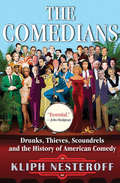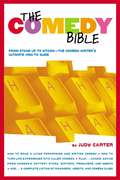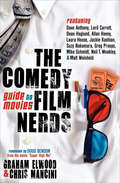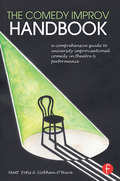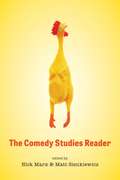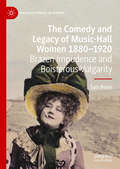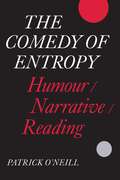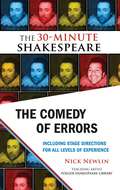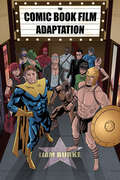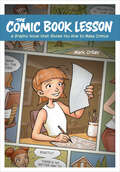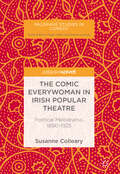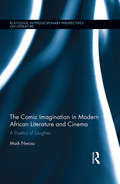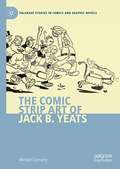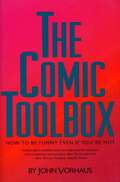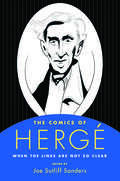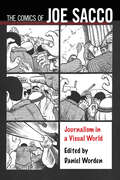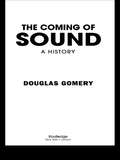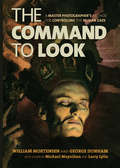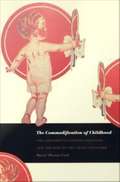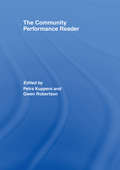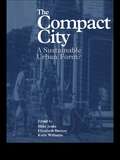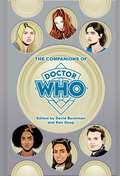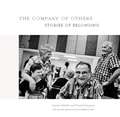- Table View
- List View
The Comedians: Drunks, Thieves, Scoundrels, and the History of American Comedy
by Kliph NesteroffIn The Comedians, comedy historian Kliph Nesteroff brings to life a century of American comedy with real-life characters, forgotten stars, mainstream heroes and counterculture iconoclasts. Based on over two hundred original interviews and extensive archival research, Nesteroff’s groundbreaking work is a narrative exploration of the way comedians have reflected, shaped, and changed American culture over the past one hundred years.Starting with the vaudeville circuit at the turn of the last century, Nesteroff introduces the first stand-up comedian-an emcee who abandoned physical shtick for straight jokes. After the repeal of Prohibition, Mafia-run supper clubs replaced speakeasies, and mobsters replaced vaudeville impresarios as the comedian’s primary employer. In the 1950s, the late-night talk show brought stand-up to a wide public, while Lenny Bruce, Mort Sahl, and Jonathan Winters attacked conformity and staged a comedy rebellion in coffeehouses. From comedy’s part in the Civil Rights movement and the social upheaval of the late 1960s, to the first comedy clubs of the 1970s and the cocaine-fueled comedy boom of the 1980s, The Comedians culminates with a new era of media-driven celebrity in the twenty-first century.
The Comedy Bible: From Stand-up to Sitcom--the Comedy Writer's Ultimate "How To" Guide
by Judy CarterDo you think you're funny? Do you want to turn your sense of humor into a career? If the answer is yes, then Judy Carter's The Comedy Bible is for you. The guru to aspiring stand-up comics provides the complete scoop on being -- and writing -- funny for money. If you've got a sense of humor, you can learn to make a career out of comedy, says Judy Carter. Whether it's creating a killer stand-up act, writing a spec sitcom, or providing jokes for radio or one-liners for greeting cards, Carter provides step-by-step instructions in The Comedy Bible. She helps readers first determine which genre of comedy writing or performing suits them best and then directs them in developing, refining, and selling their work. Using the hands-on workbook format that was so effective in her bestselling first book, Stand-Up Comedy: The Book, Carter offers a series of day-by-day exercises that draw on her many years as a successful stand-up comic and the head of a nationally known comedy school. Also included are practical tips and advice from today's top comedy professionals -- from Bernie Brillstein to Christopher Titus to Richard Lewis. She presents the pros and cons of the various comedy fields -- stand-up, script, speech and joke writing, one-person shows, humor essays -- and shows how to tailor your material for each. She teaches how to find your "authentic" voice -- the true source of comedy. And, perhaps most important, Carter explains how to take a finished product to the next level -- making money -- by pitching it to a buyer and negotiating a contract. Written in Carter's unique, take-no-prisoners voice, The Comedy Bible is practical, inspirational, and funny.
The Comedy Film Nerds Guide to Movies: Featuring Dave Anthony, Lord Carrett, Dean Haglund, Allan Havey, Laura House, Jackie Kashian, Suzy Nakamura, Greg ... Schmidt, Neil T. Weakley, and Matt Weinhold
by Chris Mancini Graham ElwoodA movie guide for film and comedy fans, by filmmakers and comedians, for the movie lover with a good sense of humor. Tired of the usual boring, dry movie discussion? The Comedy Film Nerds Guide to Movies is something new. Is it serious movie discussion? Is it funny? Do the writers know what the hell they are talking about? Yes, yes, yes, and yes. Okay, that&’s too many yes&’s, but you get the point. Graham Elwood and Chris Mancini, both professional filmmakers and comedians, created comedyfilmnerds.com to mind meld the idea of real movie talk and real funny. And they called in all of their professionally funny and filmy friends to help them. Comedians and writers who have been on everything from the Tonight Show to their own comedy specials tell you what&’s what about their favorite film genres. While The Comedy Film Nerds Guide to Movies is funny and informative, each genre is given a personal touch. All of the Comedy Film Nerds have a love of film and a personal connection to each genre. Read about a love of film from an insider&’s perspective. The Comedy Film Nerds Guide to Movies brings what has been missing from movie discussion for too long: a healthy dose of humor.
The Comedy Improv Handbook: A Comprehensive Guide to University Improvisational Comedy in Theatre and Performance
by Matt Fotis Siobhan O'HaraThe Comedy Improv Handbook: A Comprehensive Guide to University Improvisational Comedy in Theatre and Performance is a one-stop resource for both improv teachers and students, covering improv history, theory, maxims, exercises, games, and structures. You will learn the necessary skills and techniques needed to become a successful improviser, developing a basic understanding of the history of improvisation and its major influences, structures, and theories. This book also addresses issues associated with being a college improviser – like auditions, rehearsals, performances, and the dynamics of improv groups.
The Comedy Studies Reader
by Nick Marx Matt SienkiewiczFrom classical Hollywood film comedies to sitcoms, recent political satire, and the developing world of online comedy culture, comedy has been a mainstay of the American media landscape for decades. Recognizing that scholars and students need an authoritative collection of comedy studies that gathers both foundational and cutting-edge work, Nick Marx and Matt Sienkiewicz have assembled The Comedy Studies Reader. This anthology brings together classic articles, more recent works, and original essays that consider a variety of themes and approaches for studying comedic media—the carnivalesque, comedy mechanics and absurdity, psychoanalysis, irony, genre, race and ethnicity, gender and sexuality, and nation and globalization. The authors range from iconic theorists, such as Mikhail Bakhtin, Sigmund Freud, and Linda Hutcheon, to the leading senior and emerging scholars of today. As a whole, the volume traces two parallel trends in the evolution of the field—first, comedy’s development into myriad subgenres, formats, and discourses, a tendency that has led many popular commentators to characterize the present as a “comedy zeitgeist”; and second, comedy studies’ new focus on the ways in which comedy increasingly circulates in “serious” discursive realms, including politics, economics, race, gender, and cultural power.
The Comedy and Legacy of Music-Hall Women 1880-1920: Brazen Impudence and Boisterous Vulgarity (Palgrave Studies in Comedy)
by Sam BealeThis book explores the comedy and legacy of women working as performers on the music-hall stage from 1880–1920, and examines the significance of their previously overlooked contributions to British comic traditions. Focusing on the under-researched female ‘serio-comic’, the study includes six micro-histories detailing the acts of Ada Lundberg, Bessie Bellwood, Maidie Scott, Vesta Victoria, Marie Lloyd and Nellie Wallace. Uniquely for women in the late-nineteenth and early-twentieth centuries, these pioneering performers had public voices. The extent to which their comedy challenged Victorian and Edwardian perceptions of women is revealed through explorations of how they connected with popular audiences while also avoiding censorship. Their use of techniques such as comic irony and stereotyping, self-deprecation, and comic innuendo are considered alongside the work of contemporary stand-up comedians and performance artists including Bridget Christie, Bryony Kimmings, Sara Pascoe, Shazia Mirza and Sarah Silverman.
The Comedy of Entropy: Humour/Narrative/Reading (The Royal Society of Canada Special Publications)
by Patrick O'NeillEntropic comedy is the phrase coined by Patrick O'Neill in this study to identify a particular mode of twentieth-century narrative that is not generally recognized. He describes it as the narrative expression of forms of decentred humour, or what might more loosely be called 'black humour.'O'Neill begins his investigation by examining the rise of an essentially new form of humour over the last three hundred years or so in the context of a rapid decay of confidence in traditional authoritative value systems. O'Neill analyses the resulting reorganization of the spectrum of humour, and examines th implications of this for the ways in which we read texts and the world we live in.He then turns from intellectual history to narratology and considers the relationship, in theoretical terms, of homour, play, and narrative as systems of discourse and the role of the reader as a textualizing agent.Finally, he considers some dozen twentieth-century narratives in French, German, and English (with occasional reference to other literatures) in the context of those historical and theoretical concerns. Authors of the texts analysed include Céline, Camus, Satre, and Robbe-Grillet in French; Heller, Beckett, Pynchon, Nabokov, and Joyce in English; Grass, Kafka, and Handke in German. The analyses proceed along lines suggested by structuralist, semiotic, and post-structuraist narrative and literary theory. From his analyses of these works O'Neill concludes they illustrate in narrative terms a mode of modern writing definable as entropic comedy, and he develops a taxonomy of the mode.
The Comedy of Errors: The 30-Minute Shakespeare
by Nick NewlinThe Comedy of Errors: The 30-Minute Shakespeare offers five raucous scenes from this extravaganza of mistaken identity.The abridgement begins with a dramatic physical enactment of the twins' separation at sea. The play continues with a series of foibles featuring Antipholus of Ephesus, Dromio of Ephesus, and their identical twin counterparts from Antipholus.Adriana and Luciana receive hysterically misguided attention from the twins. Emilia and Egeon as the long-lost parents, and the riotous conjurer Dr. Pinch round out the cast of characters in Shakespeare's most uproarious comedy.The edition includes a preface by Nick Newlin containing helpful advice on how to put on a Shakespeare performance in a high school class with novice actors, as well as an appendix with suggestions for the specific play and recommendations for further resources.
The Comic Book Film Adaptation: Exploring Modern Hollywood's Leading Genre
by Liam BurkeIn the summer of 2000 X-Men surpassed all box office expectations and ushered in an era of unprecedented production of comic book film adaptations. This trend, now in its second decade, has blossomed into Hollywood's leading genre. From superheroes to Spartan warriors, The Comic Book Film Adaptation offers the first dedicated study to examine how comic books moved from the fringes of popular culture to the center of mainstream film production.Through in-depth analysis, industry interviews, and audience research, this book charts the cause-and-effect of this influential trend. It considers the cultural traumas, business demands, and digital possibilities that Hollywood faced at the dawn of the twenty-first century. The industry managed to meet these challenges by exploiting comics and their existing audiences. However, studios were caught off-guard when these comic book fans, empowered by digital media, began to influence the success of these adaptations. Nonetheless, filmmakers soon developed strategies to take advantage of this intense fanbase, while codifying the trend into a more lucrative genre, the comic book movie, which appealed to an even wider audience. Central to this vibrant trend is a comic aesthetic in which filmmakers utilize digital filmmaking technologies to engage with the language and conventions of comics like never before.The Comic Book Film Adaptation explores this unique moment in which cinema is stimulated, challenged, and enriched by the once-dismissed medium of comics.
The Comic Book Lesson: A Graphic Novel That Shows You How to Make Comics
by Mark CrilleyAn aspiring young creator learns the fundamentals of visual storytelling from three comic book mentors in this charming illustrated tale—a graphic novel that teaches you how to turn your stories into comics!Acclaimed illustrator and graphic novelist Mark Crilley returns with a new approach to learning the essential elements of making comics. His easy-to-follow instruction about comic book art, design, and storytelling provides aspiring creators a one-of-a-kind how-to experience. In The Comic Book Lesson, you&’ll meet Emily—an enthusiastic young comics fan who has a story she needs to tell. On her quest to turn that story into a comic book, Emily meets three helpful mentors who share their knowledge. Trudy, a high school student who works at the local comics shop, teaches Emily how to create expressive characters and how art can convey action and suspense. Madeline, a self-published manga artist, teaches Emily how to use panel composition and layout to tell a story visually and how to develop a comic from script to sketch to finished pages. Sophie, a professional graphic novelist, guides Emily through fine-tuning the details of dialogue, sequence, and pacing to lead readers through the story. Page by page, you&’ll discover more about the events that drive Emily to create her comic book as her mentors teach her (and you!) about the fundamentals of visual narrative and comic book art. Each lesson builds on the previous one, guiding you through the steps of planning and creating your comic, with accompanying exercises you can try for yourself. Are you ready to start your comic book lesson today?
The Comic Everywoman in Irish Popular Theatre: Political Melodrama, 1890-1925 (Palgrave Studies in Comedy)
by Susanne CollearyThis book is a comprehensive study of comic women in performance as Irish Political Melodrama from 1890 to 1925. It maps out the performance contexts of the period, such as Irish “poor” theatre both reflecting and complicating narratives of Irish Identity under British Rule. The study investigates the melodramatic aesthetic within these contexts and goes on to analyse a selection of the melodramas by the playwrights J.W. Whitbread and P.J. Bourke. In doing so, the analyses makes plain the comic structures and intent that work across both character and action, foregrounding comic women at the centre of the discussion. Finally, the book applies a “practice as research” dimension to the study. Working through a series of workshops, rehearsals and a final performance, Colleary investigates comic identity and female performance through a feminist revisionist lens. She ultimately argues that the formulation of the Comic Everywoman as staged “Comic” identity can connect beyond the theatre to her “Everyday” self. This book is intended for those interested in theatre histories, comic women and in popular performance.
The Comic Imagination in Modern African Literature and Cinema: A Poetics of Laughter (Routledge Interdisciplinary Perspectives on Literature)
by Maik NwosuThis book is a seminal study that significantly expands the interdisciplinary discourse on African literature and cinema by exploring Africa’s under-visited carnivalesque poetics of laughter. Focusing on modern African literature as well as contemporary African cinema, particularly the direct-to-video Nigerian film industry known as Nollywood, the book examines the often-neglected aesthetics of the African comic imagination. In modern African literature, which sometimes creatively traces a path back to African folklore, and in Nollywood — with its aesthetic relationship to Onitsha Market Literature — the pertinent styles range from comic simplicitas to comic magnitude with the facilitation of language, characterization, and plot by a poetics of laughter or lightness as an important aspect of style. The poetics at work is substantially carnivalesque, a comic preference or tendency that is attributable, in different contexts, to a purposeful comic sensibility or an unstructured but ingrained or virtual comic mode. In the best instances of this comic vision, the characteristic laughter or lightness can facilitate a revaluation or reappreciation of the world, either because of the aesthetic structure of signification or the consequent chain of signification. This referentiality or progressive signification is an important aspect of the poetics of laughter as the African comic imagination variously reflects, across genres, both the festival character of comedy and its pedagogical value. This book marks an important contribution to African literature, postcolonial literature, world literature, comic imagination, poetics, critical theory, and African cinema.
The Comic Strip Art of Jack B. Yeats (Palgrave Studies in Comics and Graphic Novels)
by Michael ConnertyThis monograph seeks to recover and assess the critically neglected comic strip work produced by the Irish painter Jack B. Yeats for various British publications, including Comic Cuts, The Funny Wonder, and Puck, between 1893 and 1917. It situates the work in relation to late-Victorian and Edwardian media, entertainment and popular culture, as well as to the evolution of the British comic during this crucial period in its development. Yeats’ recurring characters, including circus horse Signor McCoy, detective pastiche Chubblock Homes, and proto-superhero Dicky the Birdman, were once very well-known, part of a boom in cheap and widely distributed comics that Alfred Harmsworth and others published in London from 1890 onwards. The repositioning of Yeats in the context of the comics, and the acknowledgement of the very substantial corpus of graphic humour that he produced, has profound implications for our understanding of his artistic career and of his significant contribution to UK comics history. This book, which also contains many examples of the work, should therefore be of value to those interested in Comics Studies, Irish Studies, and Art History.
The Comic Toolbox: How To Be Funny Even If You're Not
by John VorhausA workbook approach to comedy writing as creative problem-solving. It offers tools of the trade such as Clash of Context, Tension and Release, The Law of Comic Opposites, The Wildly Inappropriate Response, and The Myth of the Last Great Idea to writers, comics, and anyone else who wants to be funny.
The Comics of Hergé: When the Lines Are Not So Clear (Critical Approaches to Comics Artists Series)
by Joe Sutliff SandersContributions by Jônathas Miranda de Araújo, Guillaume de Syon, Hugo Frey, Kenan Koçak, Andrei Molotiu, Annick Pellegrin, Benjamin Picado, Vanessa Meikle Schulman, Matthew Screech, and Gwen Athene Tarbox As the creator of Tintin, Hergé (1907–1983) remains one of the most important and influential figures in the history of comics. When Hergé, born Georges Prosper Remi in Belgium, emerged from the controversy surrounding his actions after World War II, his most famous work leapt to international fame and set the standard for European comics. While his style popularized what became known as the “clear line” in cartooning, this edited volume shows how his life and art turned out much more complicated than his method. The book opens with Hergé’s aesthetic techniques, including analyses of his efforts to comprehend and represent absence and the rhythm of mundaneness between panels of action. Broad views of his career describe how Hergé navigated changing ideas of air travel, while precise accounts of his life during Nazi occupation explain how the demands of the occupied press transformed his understanding of what a comics page could do. The next section considers a subject with which Hergé was himself consumed: the fraught lines between high and low art. By reading the late masterpieces of the Tintin series, these chapters situate his artistic legacy. A final section considers how the clear line style has been reinterpreted around the world, from contemporary Francophone writers to a Chinese American cartoonist and on to Turkey, where Tintin has been reinvented into something meaningful to an audience Hergé probably never anticipated. Despite the attention already devoted to Hergé, no multi-author critical treatment of his work exists in English, the majority of the scholarship being in French. With contributors from five continents drawing on a variety of critical methods, this volume’s range will shape the study of Hergé for many years to come.
The Comics of Joe Sacco: Journalism in a Visual World (Critical Approaches to Comics Artists Series)
by Daniel WordenNamed a Notable Scholarly Publication of 2015 by the Comics Studies SocietyContributions by Georgiana Banita, Lan Dong, Ann D'Orazio, Kevin C. Dunn, Alexander Dunst, Jared Gardner, Edward C. Holland, Isabel Macdonald, Brigid Maher, Ben Owen, Rebecca Scherr, Maureen Shay, Marc Singer, Richard Todd Stafford, and Øyvind VågnesThe Comics of Joe Sacco addresses the range of his award-winning work, from his early comics stories as well as his groundbreaking journalism Palestine (1993) and Safe Area to Goražde (2000), to Footnotes in Gaza (2009) and his most recent book The Great War (2013), a graphic history of World War I.First in the series, Critical Approaches to Comics Artists, this edited volume explores Sacco's comics journalism and features established and emerging scholars from comics studies, cultural studies, geography, literary studies, political science, and communication studies. Sacco's work has already found a place in some of the foundational scholarship in comics studies, and this book solidifies his role as one of the most important comics artists today.Sections focus on how Sacco's comics journalism critiques and employs the standard of objectivity in mainstream reporting, what aesthetic principles and approaches to lived experience can be found in his comics, how Sacco employs the space of the comics page to map history and war, and the ways that his comics function in the classroom and as human rights activism. The Comics of Joe Sacco offers definitive, exciting approaches to some of the most important--and necessary--comics today, by one of the most acclaimed journalist-artists of our time.
The Coming of Age of Urban Agriculture (Contemporary Urban Design Thinking)
by Rob RoggemaFor a long time, urban agriculture initiatives have been explored and novel policy and planning practices have been investigated. With the global food crisis the role urban agriculture has to play becomes more and more urgent. The potentials are large: it brings social justice, it limits climate change, it provides a healthy urban condition, it stimulates biodiversity and gives disadvantaged people an economic opportunity. After 15 years in the making, the time is ripe to see whether the growing of food has established a prominent position in urban planning and policies, food productivity, safety and security, social well-being, the arts, and human health. In this volume several aspects of growing food in the city are explored. Urban Agriculture plays a significant role in society. Nevertheless, it did not become a mainstream topic in day-to-day practice. This book provides concrete solutions and clues how to give urban food production a crucial role in the future planning of urban environments.
The Coming of Sound
by Douglas GomeryThe coming of sound to film was an event whose importance can hardly be overestimated; sound transformed not only the Hollywood film industry but all of world cinema as well. As economic and film historian Douglas Gomery explains, the business of film became not only bigger but much more complex. As sound spread its power, the talkies became an agent of economic and social change through the globe, extending America's reach in ways that had never before been imaginable.This is an essential work for anyone interested in early film, film history and economics, and the history of the American media.
The Command to Look
by Michael Moynihan George Dunham Larry Lytle William MortensenThe Command to Look was one of William Mortensen's most influential and sought-after books, and has been out of print for fifty years. Reproduced here in full, this book includes an essay by Michael Moynihan on how its images influenced the occult "lesser magic" of the founder of the Church of Satan, Anton Szandor LaVey.The book reproduces fifty-five images of Mortensen's best work and text by the wittiest and most biting writers on photography of their time.
The Commodification of Childhood: The Children's Clothing Industry and the Rise of the Child Consumer
by Daniel Thomas CookIn this revealing social history, Daniel Thomas Cook explores the roots of children's consumer culture--and the commodification of childhood itself--by looking at the rise, growth, and segmentation of the children's clothing industry. Cook describes how in the early twentieth century merchants, manufacturers, and advertisers of children's clothing began to aim commercial messages at the child rather than the mother. Cook situates this fundamental shift in perspective within the broader transformation of the child into a legitimate, individualized, self-contained consumer. The Commodification of Childhood begins with the publication of the children's wear industry's first trade journal, The Infants' Department, in 1917 and extends into the early 1960s, by which time the changes Cook chronicles were largely complete. Analyzing trade journals and other documentary sources, Cook shows how the industry created a market by developing and promulgating new understandings of the "nature," needs, and motivations of the child consumer. He discusses various ways that discursive constructions of the consuming child were made material: in the creation of separate children's clothing departments, in their segmentation and layout by age and gender gradations (such as infant, toddler, boys, girls, tweens, and teens), in merchants' treatment of children as individuals on the retail floor, and in displays designed to appeal directly to children. Ultimately, The Commodification of Childhood provides a compelling argument that any consideration of "the child" must necessarily take into account how childhood came to be understood through, and structured by, a market idiom.
The Common Camp: Architecture of Power and Resistance in Israel–Palestine
by Irit KatzSeeing the camp as a persistent political instrument in Israel–Palestine and beyondThe Common Camp underscores the role of the camp as a spatial instrument employed for reshaping, controlling, and struggling over specific territories and populations. Focusing on the geopolitical complexity of Israel–Palestine and the dramatic changes it has experienced during the past century, this book explores the region&’s extensive networks of camps and their existence as both a tool of colonial power and a makeshift space of resistance. Examining various forms of camps devised by and for Zionist settlers, Palestinian refugees, asylum seekers, and other groups, Irit Katz demonstrates how the camp serves as a common thread in shaping lands and lives of subjects from across the political spectrum. Analyzing the architectural and political evolution of the camp as a modern instrument engaged by colonial and national powers (as well as those opposing them), Katz offers a unique perspective on the dynamics of Israel–Palestine, highlighting how spatial transience has become permanent in the ongoing story of this contested territory. The Common Camp presents a novel approach to the concept of the camp, detailing its varied history as an apparatus used for population containment and territorial expansion as well as a space of everyday life and subversive political action. Bringing together a broad range of historical and ethnographic materials within the context of this singular yet versatile entity, the book locates the camp at the core of modern societies and how they change and transform.
The Community Performance Reader
by Petra Kuppers Gwen RobertsonCommunity Performance: A Reader is the first book to provide comprehensive teaching materials for this significant part of the theatre studies curriculum. It brings together core writings and critical approaches to community performance work, presenting practices in the UK, USA, Australia and beyond. Offering a comprehensive anthology of key writings in the vibrant field of community performance, spanning dance, theatre and visual practices, this Reader uniquely combines classic writings from major theorists and practitioners such as Augusto Boal, Paolo Freire, Dwight Conquergood and Jan Cohen Cruz, with newly commissioned essays that bring the anthology right up to date with current practice. This book can be used as a stand-alone text, or together with its companion volume, Community Performance: An Introduction, to offer an accessible and classroom-friendly introduction to the field of community performance.
The Compact City: A Sustainable Urban Form?
by Katie Williams Mike Jenks Elizabeth BurtonThis book presents the latest thinking on the benefits and dangers of higher density urban living. It offers diverse opinions and research, from a wide range of disciplines, and gives an insight into both the theoretical debate and the practical challenges surrounding the compact city. Essential reading for anyone with an interest in sustainable urban development.
The Companions of Dr. Who: The Best Of Him (Doctor Who)
by David BushmanDoctor Who fans love to argue: Who's the best Doctor? Who's the best showrunner? And here in this anthology of essays, a roster of Who experts present their arguments for who's the best companion, and come up with some surprising nominations. "Don't be alone, Doctor," Amy Pond tells the Eleventh Doctor in "The Angels Take Manhattan," and of course the irony is that in one sense the Doctor is always alone--a Gallifreyan whose regenerative powers mean he will outlast nearly everyone near and dear to him -- while at the same time he is rarely without one or more trusted companion by his side. This is a book about those companions--those fortunate few who accompany him on his journeys through space and time on--to quote the Ninth Doctor--"the trip of a lifetime." The editors of The Villains of Doctor Who are back with a new anthology of essays--paeans, really--to Donna Noble, Sarah Jane Smith, Rose Tyler, Wilfred Mott, Chang Lee, Clara Oswald, and more. Did your favorite companion make the cut? You're going to have to read to find out! Edited by David Bushman (The Villains of Doctor Who) and Ken Deep (Showrunner of L.I Doctor Who Con) Essays by: Shaun Lyon, Joseph Dougherty, Mackenzie Flohr, Amanda-Rae Prescott, Scott Ryan, Gina R Rosich, PhD, MSW, Joshua Lou Friedman, Yee Jee Tso, Sophie Aldred, Paul J. Salamoff, Charlie Ross, Lucy Chase Williams, Amy Krell, Edwin Thrower, and Barnaby Edwards
The Company of Others
by John Ralston Saul Sandra Shields David CampionIn the next decade, six million North American families will be caring for someone with a disability. But other disabled people are not so lucky, left to live in isolation and without support in an era of federal and state cutbacks. This extraordinary book is about the transforming power of family and community on "vulnerable" individuals--the mentally challenged, the mentally ill, the elderly--and how these efforts enrich us as a society. The book tells the stories, interwoven with photographs, of five such people, who are surrounded by social "circles--friends and family whose respect, encouragement, and unconditional love give them a sense of purpose and belonging. Featuring beautiful duotone photographs, the stories told here are profoundly inspiring, giving hope to anyone who, because of age, health, or disability, has been excluded from having a full and meaningful life.Co-produced with PLAN (Planned Lifetime Advocacy Network).
